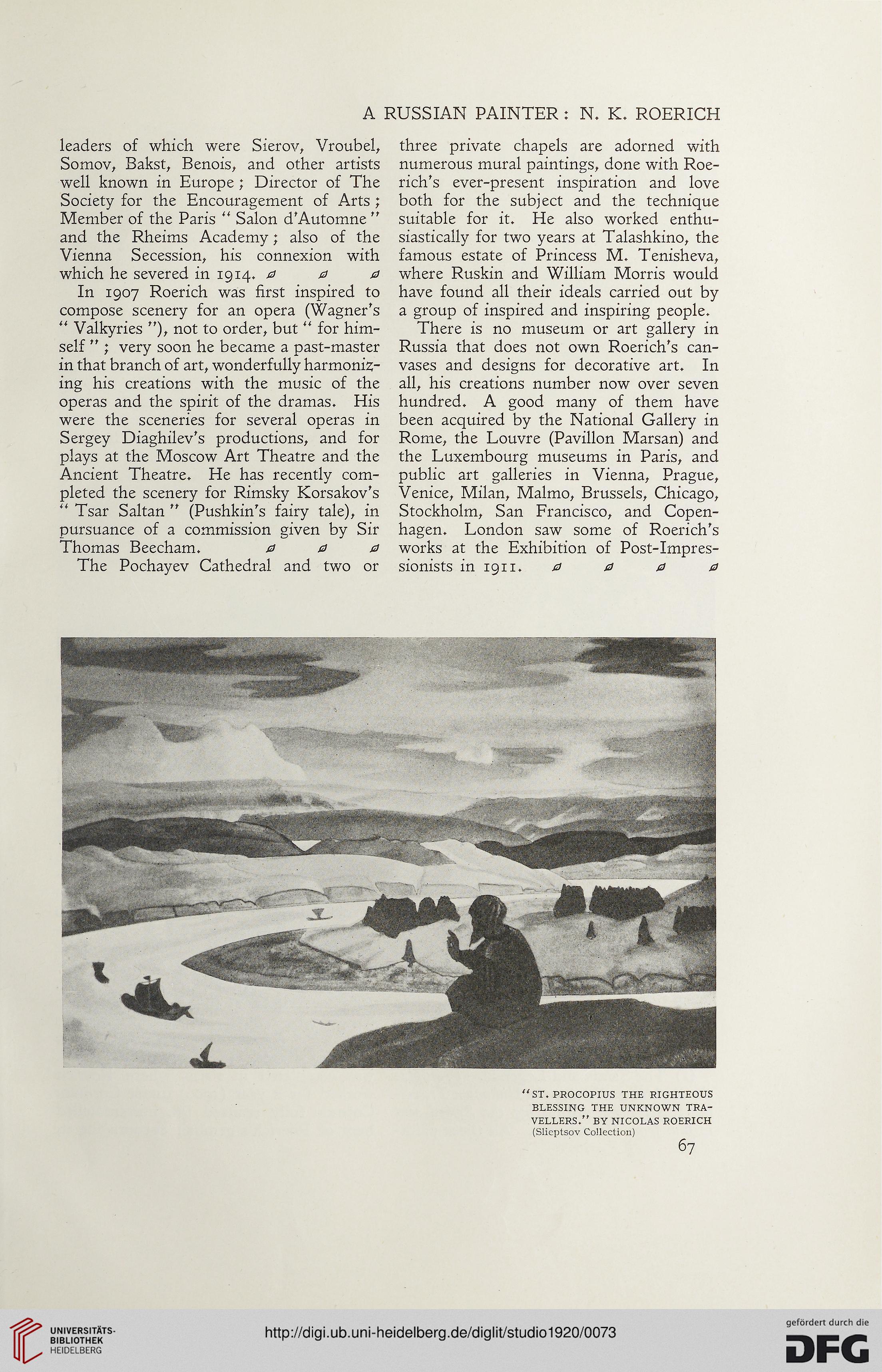A RUSSIAN PAINTER : N. K. ROERICH
leaders of which were Sierov, Vroubel,
Somov, Bakst, Benois, and other artists
well known in Europe ; Director of The
Society for the Encouragement of Arts ;
Member of the Paris “ Salon d'Automne ''
and the Rheims Academy; also of the
Vienna Secession, his connexion with
which he severed in 1914. 000
In 1907 Roerich was first inspired to
compose scenery for an opera (Wagner's
u Valkyries ''), not to order, but u for him-
self ''; very soon he became a past-master
in that branch of art, wonderfully harmoniz-
ing his creations with the music of the
operas and the spirit of the dramas. His
were the sceneries for several operas in
Sergey Diaghilev's productions, and for
plays at the Moscow Art Theatre and the
Ancient Theatre. He has recently com-
pleted the scenery for Rimsky Korsakov's
“ Tsar Saltan " (Pushkin's fairy tale), in
pursuance of a commission given by Sir
Thomas Beecham. 0 0 0
The Pochayev Cathedral and two or
three private chapels are adorned with
numerous mural paintings, done with Roe-
rich's ever-present inspiration and love
both for the subject and the technique
suitable for it. He also worked enthu-
siastically for two years at Talashkino, the
famous estate of Princess M. Tenisheva,
where Ruskin and William Morris would
have found all their ideals carried out by
a group of inspired and inspiring people.
There is no museum or art gallery in
Russia that does not own Roerich's can-
vases and designs for decorative art. In
all, his creations number now over seven
hundred. A good many of them have
been acquired by the National Gallery in
Rome, the Louvre (Pavilion Marsan) and
the Luxembourg museums in Paris, and
public art galleries in Vienna, Prague,
Venice, Milan, Malmo, Brussels, Chicago,
Stockholm, San Francisco, and Copen-
hagen. London saw some of Roerich's
works at the Exhibition of Post-Impres-
sionists in 1911. 0000
“ST. PROCOPIUS THE RIGHTEOUS
BLESSING THE UNKNOWN TRA-
VELLERS.” BY NICOLAS ROERICH
(Slieptsov Collection)
67
leaders of which were Sierov, Vroubel,
Somov, Bakst, Benois, and other artists
well known in Europe ; Director of The
Society for the Encouragement of Arts ;
Member of the Paris “ Salon d'Automne ''
and the Rheims Academy; also of the
Vienna Secession, his connexion with
which he severed in 1914. 000
In 1907 Roerich was first inspired to
compose scenery for an opera (Wagner's
u Valkyries ''), not to order, but u for him-
self ''; very soon he became a past-master
in that branch of art, wonderfully harmoniz-
ing his creations with the music of the
operas and the spirit of the dramas. His
were the sceneries for several operas in
Sergey Diaghilev's productions, and for
plays at the Moscow Art Theatre and the
Ancient Theatre. He has recently com-
pleted the scenery for Rimsky Korsakov's
“ Tsar Saltan " (Pushkin's fairy tale), in
pursuance of a commission given by Sir
Thomas Beecham. 0 0 0
The Pochayev Cathedral and two or
three private chapels are adorned with
numerous mural paintings, done with Roe-
rich's ever-present inspiration and love
both for the subject and the technique
suitable for it. He also worked enthu-
siastically for two years at Talashkino, the
famous estate of Princess M. Tenisheva,
where Ruskin and William Morris would
have found all their ideals carried out by
a group of inspired and inspiring people.
There is no museum or art gallery in
Russia that does not own Roerich's can-
vases and designs for decorative art. In
all, his creations number now over seven
hundred. A good many of them have
been acquired by the National Gallery in
Rome, the Louvre (Pavilion Marsan) and
the Luxembourg museums in Paris, and
public art galleries in Vienna, Prague,
Venice, Milan, Malmo, Brussels, Chicago,
Stockholm, San Francisco, and Copen-
hagen. London saw some of Roerich's
works at the Exhibition of Post-Impres-
sionists in 1911. 0000
“ST. PROCOPIUS THE RIGHTEOUS
BLESSING THE UNKNOWN TRA-
VELLERS.” BY NICOLAS ROERICH
(Slieptsov Collection)
67




